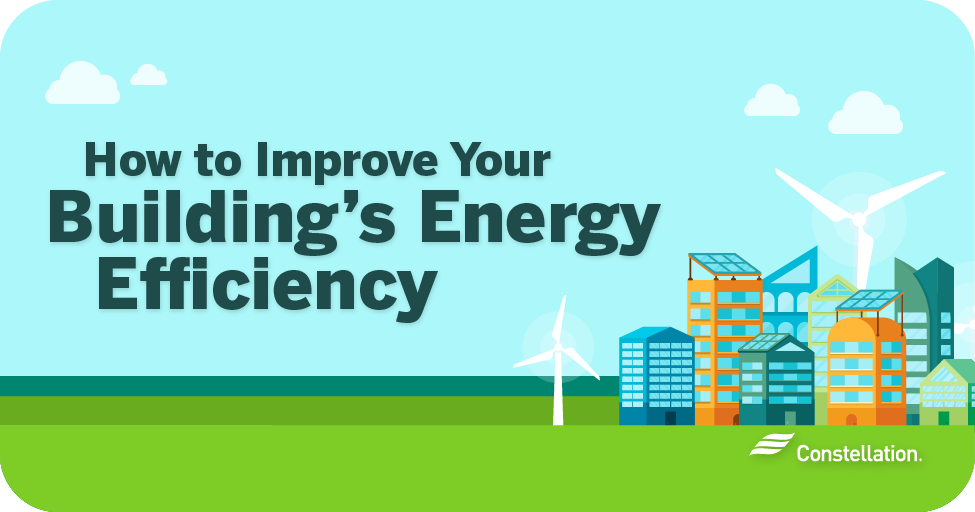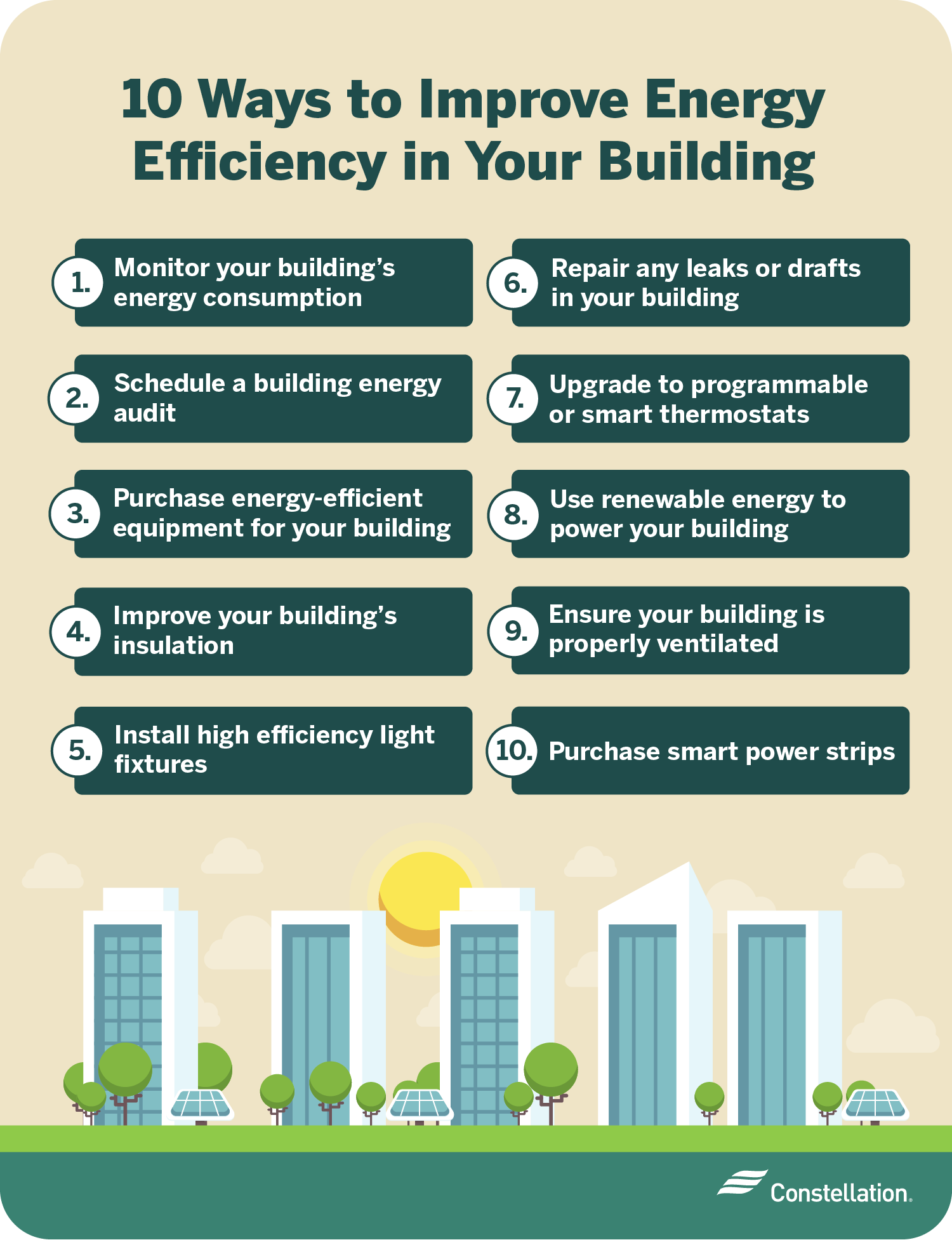
- Category:
Small Business Energy Savings -
Last updated:
May 25, 2023
How to Improve Your Building’s Energy Efficiency
Since heating, cooling and operating buildings accounts for a significant amount of energy consumption, it’s important to find ways to improve your building’s energy efficiency.
What is energy efficiency in a building and why is it important?
Taking the time to learn how to improve energy efficiency in your building can help your company make a substantial reduction in energy usage and carbon emissions. Buildings account for some 30% of global energy consumption, according to a 2021 International Energy Agency report.
Reducing that burden on global power systems has multiple benefits, including saving money, protecting the environment by reducing our carbon footprint, improving community health, and increasing power grid resilience.
How do you measure building efficiency?
Energy efficiency in buildings is measured by the power consumed to keep spaces warm in winter, cool in summer, and at the proper humidity level. Buildings also use power for lighting and any electrical equipment needed to operate the building, such as heating water, providing security and operating doors and elevators.
Types of building energy efficiency ratings
The two best-known building energy efficiency rating systems are the US Environmental Protection Agency’s ENERGY STAR® building score and the US Green Building Council’s LEED Leadership in Energy and Environmental Design certification.
- The ENERGY STAR® building energy efficiency score ranges from 1 to 100. Buildings that score 50 are median performers. Scores above 75 are eligible for ENERGY STAR® certification.
- LEED certification is more complex, with separate ratings for building design and construction, operations and maintenance, and interior design and construction. Buildings need to score 40-49 points to be certified. Silver status is awarded to buildings with 50-59 points, gold requires 60-79 points and platinum buildings rack up over 80 points.
10 ways to improve energy efficiency in your building

How to improve energy efficiency in buildings is an area of rapid innovation. New technologies and methods for improving energy efficiency are constantly being introduced. And they don’t apply just to new buildings. You can do quite a bit to increase the energy efficiency of existing buildings.
1. Monitor your building’s energy consumption
Indeed, when it comes to improving the energy efficiency of existing buildings, it is important to know your starting points and to uncover where to prioritize your investments. Energy monitoring is a way to do both.
You will need an energy management system that includes a network of devices that measure energy usage in all energy-consuming systems and equipment. Setting benchmarks using similar businesses and buildings can be a useful energy efficiency tool.
2. Schedule a building energy audit
Conducting an energy audit of your business gives you a professional assessment of how your company and building are using energy. When you have a clear understanding of your energy usage, you can develop strategies for how to improve energy efficiency in buildings.
3. Purchase energy-efficient equipment for your building
Using the most energy-efficient office equipment possible in your building will cut your energy use. For many, computers, phones, copiers, and servers are running all day, driving up electricity usage.
When you upgrade to efficient equipment, the impact is immediate and noticeable. You may also operate other equipment powered by electricity in your business. Upgrading these systems is also important.
4. Improve your building’s insulation
Heating and cooling your work spaces is a major part of your power bill. Improving insulation in walls, ceilings, and around windows and doors cuts your electricity usage all year round. Windows in green buildings bring in natural light. They can, however, drive up the temperature on hot days. That is why it pays to insulate windows to keep out the heat in summer.
5. Install high efficiency light fixtures
Lighting is another high-energy category for most businesses. Productivity and safety require a certain standard of light. You don’t have to trade off brightness and comfort for energy efficiency with the best commercial lighting options.
Choose between LED vs. CFL bulbs that use a fraction of the energy traditional bulbs use. Also upgrade to energy-efficient outdoor lighting. And don’t forget the value of using natural light and turning off fixtures when possible during the day.
6. Repair any leaks or drafts in your building
When upgrading insulation, check for leaks or drafts in your building. The areas around doors and windows are common sources of heat loss. Various types of weatherstripping can put an end to this waste. Also look at areas where utilities enter the building and close up any gaps there.
7. Upgrade to programmable or smart thermostats
A programmable or smart thermostat is one of the high-tech methods for improving building energy efficiency. The system will optimize the operation of your HVAC system based on time of day, number of people and their movements opening and closing doors, as well as the presence or absence of sunlight.
One of the ways many small businesses answer the question, are smart thermostats worth it, is in their energy savings and effortless convenience.
8. Use renewable energy to power your building
Running a building and operating a business takes energy. Perhaps you are already working to increase energy efficiency in existing buildings and employ small business sustainability solutions. You can further reduce your carbon footprint by switching to renewable energy to power your facilities.
9. Ensure your building is properly ventilated
Adding effective ventilation with fans and vents will improve energy efficiency in buildings. They are low energy options that go a long way to cutting your heating and cooling costs. Venting hot or stale air also removes excess moisture and allergens, improving indoor air quality and creating a healthier environment.
10. Purchase smart power strips
Eliminate the waste that comes with devices left in stand-by mode. Even when switched off, many electronics and appliances continue to sip electricity. Unplugging them is the answer, but remembering to do that can be hard.
Smart power strips are worth it when connected to your building’s smart system. Anything plugged into them can be managed automatically to save energy.
The benefits of making your building more energy efficient
Improving energy efficiency in buildings is good for your business in several ways:
- Lower your business’s operating costs. Using less energy reduces your operating expenses, potentially giving you a competitive advantage.
- Receive tax incentives. Many states and municipalities encourage the implementation of building energy efficiency through programs that can reduce your tax burden.
- Reduce your business’s environmental impact. Lowering your carbon footprint, improving environmental sustainability and contributing to a healthier community is good for everyone.
- Enhance your brand and business reputation. Your business benefits when you share your sustainability story and let customers know how you’re taking responsibility for contributing to a cleaner environment.
- Support power grid resilience. Demand for electricity continues to grow, putting stress on our infrastructure. Being more efficient allows the grid to safely serve more people with fewer service interruptions.




